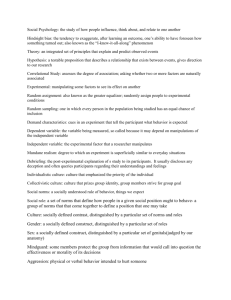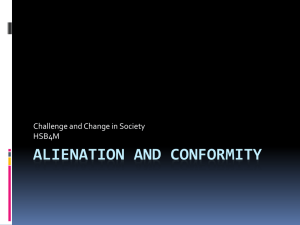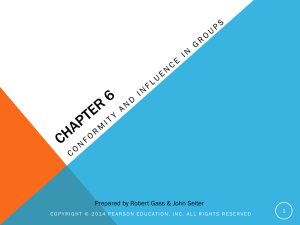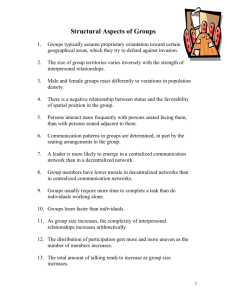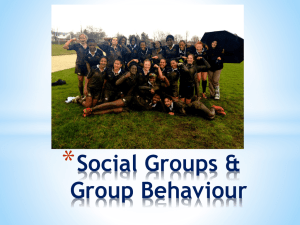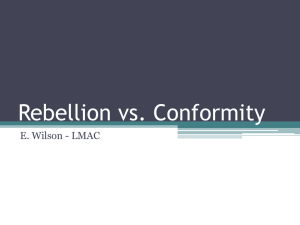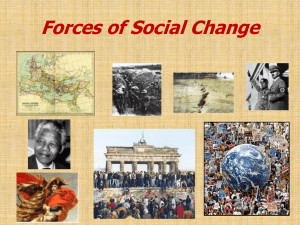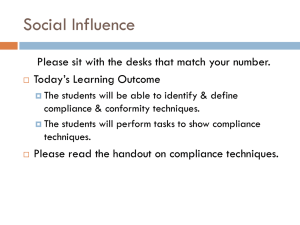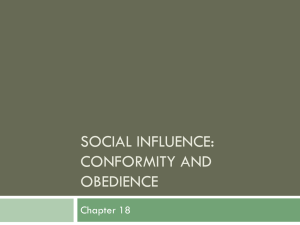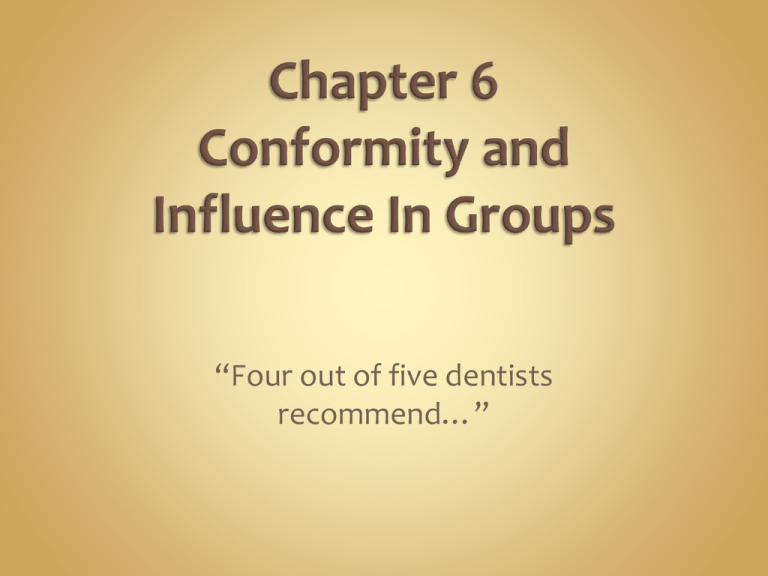
“Four out of five dentists
recommend…”
Norms are expectations
governing group member’s
behavior.
Norms may be formal,
explicit
no cheating on tests
Norms may be informal,
implicit
no picking your nose during
class
Norms may not be
apparent until violated
Is texting during class okay?
Sherif demonstrated conformity to
group judgments.
Autokinetic effect: a stationary point of light, in a
completely dark room, appears to be moving.
Individuals’ estimates of the amount of
movement conformed to the group’s.
Asch found conformity to group
judgments
Individuals estimated the length of lines.
Group members (confederates) offered
different judgments.
75% of all subjects modified their estimates to
conform to the group.
Public conformity doesn’t necessarily imply
private conformity.
Groups may punish deviation from
established norms.
Norms are most influential in ambiguous
social situations.
Subjects littered more in a setting where others were
seen littering.
Norms may persist even if they are
dysfunctional.
Social impact theory
Each additional member adds
pressure to conform.
Each new member’s influence is
proportionally less.
Social influence model
The first few people added exert
the most pressure to conform.
Conformity levels off with
additional members.
For example, if the first 9 group
members don’t convince
someone, neither will the 10th.
Informational influence
Members want to be correct, accurate.
More heads are better than one.
Consistent with social influence model
Normative influence
Members want to be liked, accepted by the group.
Groups provide a sense belonging, connectedness.
Consistent with social impact theory
It is difficult for a lone dissenter to resist
unanimous group pressure.
A holdout with even one ally can resist
more easily.
A second dissenter decreases conformity by 80%.
Identification and
reference groups
Reference groups
provide standards of
comparison for selfappraisal.
“Keeping up with the
Joneses…”
People consider
reference groups
when making
decisions.
Groupthink
Members engage in
consensus-seeking.
They reinforce one
another’s opinions.
They fail to question or
analyze ideas.
In general women tend to conform
more than men.
Sex roles affect conformity
Females are socialized to be more communal.
Males are socialized to be more independent.
Status affects conformity
Sex functions as a status cue.
Males generally enjoy higher status in
organizational settings.
Peer influence increases during
adolescence.
Peer pressure can promote
risky behaviors.
Tobacco, alcohol, drug use
Peer pressure can lead to
aggression.
Hazing, teasing, ostracism can spark
violence.
Online hazing can trigger suicides.
Peer pressure also has positive
effects.
Peers also model desirable behavior.
High self-monitors tend to conform
more than low self-monitors.
Dogmatic people tend to conform more
than non-dogmatics.
Ethnocentrism
Using one’s own culture as the benchmark for
judging other cultures.
Individualism-Collectivism
Individualistic cultures view conformity more
negatively.
Collectivistic cultures view conformity more
positively.
Group locomotion
The individual goes along to achieve the goals of the group.
Social comparison
The group is a yardstick for measuring one’s own
performance.
Consistency
Liking and identification with the group discourages deviance
Epistemological weighting
Members think the group knows more than they do.
Hedonistic hypothesis
Members conform to receive social benefits, avoid social
rejection.
Monkey see, monkey do
People base their behavior on what others are doing.
Internet piracy
Urban graffiti
Viral marketing relies on social proof
A social phenomenon is spread by word of mouth.
Negative social proof
“Everyone else is doing it” is based on appeals to the
crowd.
Slackers: People exert less effort in a group than
working alone.
The Ringlemann effect: in a tug of war, adding team members
reduces individual effort.
Decision making & problem solving: as members are added,
individual effort tapers off.
Collective effort model
Free ride effect
Sucker effect
Members coast if individuals’ contributions can’t be
distinguished.
Members coast if they are anonymous.
Members coast if they aren’t personally accountable.
Productive members slack off when they see others aren’t
working.
Risky-shift phenomenon
Groups are prone to make
riskier decisions than
individuals.
The group’s consensus is
typically riskier than the
average risk-level of its
members.
Social comparison theory
Members entertain ideas they
would not otherwise consider.
Persuasive arguments
theory (PAT)
The most vocal members
advocate the most extreme
views.
There can also be a shift
Groups enhance members’ pre- toward greater caution
Group polarization
existing tendencies toward
risk-taking or risk-aversion.
High risk-takers skew the
average willingness of the
group to assume risks.
More vocal members may
advocate greater caution.
Social ostracism can lead to anti-social
behavior
School shootings
Cyber-bullying
Depersonalization
Individual identity is subsumed to that of the group.
Personal accountability is lacking.
A diffusion of responsibility occurs.
“It’s not my problem.”
“It’s none of my business.”
Anonymity increases deindividuation.
Negative social consequences
Mob psychology
Vandalism perpetrated by unruly sports fans
Treatment of detainees at Abu Ghraib prison in Iraq
Crowd size affects antisocial behavior.
Bystander effects
Bystanders may fail to help in an emergency.
Self-Awareness
Increasing self-awareness reduces deindividuation.
Increasing accountability decreases deindividuation.
Richmond, CA, 2009: A 15
year old was the victim of a
gang rape outside her high
school’s homecoming dance.
People in a crowd who see others
doing nothing do nothing
themselves.
social proof
The ordeal lasted 2 ½ hours.
At least 20 passers-by failed
to call police.
Deindividuation
Other witnesses watched,
laughed, and took pictures.
Bystanders fail to act based on:
Increasing private awareness can
overcome the bystander effect.
Identifying individuals can
overcome the bystander effect.
“You, in the red sweater, call
911!”
“Mam, I need your help. Go pull
the fire alarm.”



